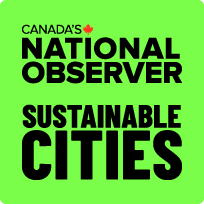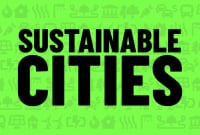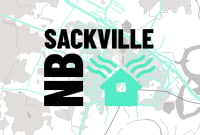
The long, costly road ahead for Winnipeg's transit improvement plans
Winnipeg is revamping its public transit system to meet 21st-century challenges. But convincing residents to get on board with the changes could be another story.
Over the last six months, Canada's National Observer has been looking into what's working and what's failing in cities across Canada as they rise to the challenge of fighting climate change. In a 13-part series, we will be taking you across the country, province by province, for a look at how cities are meeting the climate emergency with sustainable solutions.
- Winnipeg has grown to become a city of more than 700,000 — but its public transit ridership is in decline thanks to overcrowded buses and inefficient routes.
- The city knows better public transit could help lower its carbon footprint, but there's only so much cash to invest in overhauling the system — and convincing Winnipeggers to use it is another matter.
- But there are still some small victories: last year, Winnipeg unveiled Part 1 of a new bus rapid transit system, with plans to potentially move to more climate-friendly LRT trains in future.
Winnipeg’s icy winters are never easy to navigate, especially for a driver piloting a busload of people at night.
I felt awful. I could not physically make more room on that bus.
Chantale Garand, former Winnipeg Transit driver
Former Winnipeg Transit driver Chantale Garand says there was one particular night in winter 2017 that, for her, drove home how insufficient the city’s transit system was.
She was driving the late shift from the University of Manitoba to downtown, a route where buses were routinely packed from the first stop.
Garand turned north onto Pembina Highway knowing she couldn’t pick up anyone else when she saw a woman with a baby stroller waiting at the bus stop.
“I felt awful. I could not physically make more room on that bus,” Garand recalls. “I couldn’t stop thinking of her during my entire ride, even sometimes now.”
That moment was proof of Winnipeg’s overburdened public transit system, Garand says, and illustrates what happens when infrastructure fails to expand with a city’s growing population.

With declining ridership and mounting debt made worse by the pandemic, Winnipeg Transit faces a long and difficult journey to modernizing its network. But improvements to the system could cut down on pollution and convince more people to use public transit, helping Winnipeg achieve its climate goals. The city aims to slash greenhouse gas (GHG) emissions by 20 per cent from 2011 levels by 2030, and the transportation sector, which makes up half of its overall emissions, will undoubtedly play a part.

Manitoba has committed to cut its emissions by one-third over 2005 levels by 2030.

The same is true throughout the province: transportation is Manitoba's most polluting sector, making up nearly 40 per cent of overall GHG emissions. The province has committed to cut its emissions by one-third over 2005 levels by 2030.
In Winnipeg, city officials are trying to do their part by building new infrastructure with the future in mind. The city has designed a bus rapid transit (BRT) system, launched last year, to accommodate light rail transit (LRT) when the time is right, and in April, council approved a master transit plan that revamps Winnipeg Transit's route network and outlines a transition to zero-emission buses, with the full fleet becoming net zero by 2050.

We're almost 50 years behind most major Canadian cities.
Jino Distasio, urban geography professor, University of Winnipeg
Winnipeg’s transit woes date back to 1970 when the city was shifting from a trolley to a bus system. From 1972 until the mid-2000s, city leaders debated investing in a more robust service. Dozens of studies were commissioned to find the best option, but endless delays meant little got done while the city’s population reached over 700,000.
“We're almost 50 years behind most major Canadian cities, such as Calgary, Edmonton and probably even further behind some of our larger cities,” says Jino Distasio, a University of Winnipeg urban geography professor.
Now Winnipeg is moving ahead. In 2020, the city completed the Southwest Transitway, the first leg of a six-part BRT system. The 11-kilometre-long transitway, which connects the University of Manitoba to the downtown core, was originally proposed in 2008. But the plans sat idle while one city council after another dithered between BRT or LRT.
The city, under former mayor Sam Katz, eventually opted for BRT lines that transition to a light rail system in the future. Winnipeg’s BRT service is modelled on Transitway Ottawa, which is built to run on paved routes and separated from other vehicular traffic.
The choice of bus over light rail came down to price, says Distasio, who was a member of Katz’s rapid transit task force. Winnipeg was worried about the return on investment at a time when the city had stagnant urban growth and a sluggish economy. BRT was seen as key to growing a strong transportation culture that might eventually justify adding a complementary rail system, Distasio says.
By the time BRT construction began, it was widely accepted public transportation was crucial to reduce the city’s carbon footprint. A 2014 study by Sustainable Prosperity noted BRT systems, pioneered in Latin America in the mid-1970s, are cheaper than light rail or underground transit, but still effective at reducing commuting time. Bogota’s TransMilenio BRT system has resulted in “substantial reductions in local air pollutants as well as GHG emissions,” the study found.
Still, in Winnipeg it was difficult to justify the cost when residents were increasingly snubbing the city’s cold, overpacked and inefficient transit system in favour of their personal vehicles. Winnipeg is the lone city out of eight Canadian metropolitan areas where transit ridership declined between 1996 and 2016, according to Statistics Canada data. More recent numbers show a continuing trend; between 2014 and 2018, ridership dropped by a little more than three per cent.

Distasio blames city and provincial governments for failing to innovate and invest more heavily in transit, which currently runs three routes across the city and has an annual ridership of over 48 million.
I think there's been a number of times where, as a passenger, you’re feeling like you’re going to miss a very important event because our transit system isn't working.
Chantale Garand, former Winnipeg Transit driver
“Since the 1970s, we really retracted our investment in transportation and began focusing on the single bus routes,” he says. Some things worked, but others didn’t, and the city was left with a patchwork of automobiles and on-street bus delivery to only some parts of the city, Distasio says.
Having been behind the wheel of a Winnipeg bus and now riding as a passenger, Garand has experienced the challenges first-hand.
“I think there's been a number of times where, as a passenger, you’re feeling like you’re going to miss a very important event because our transit system isn't working.”
When she needs to use transit, Garand finds herself checking her phone to see when the next bus will arrive and often battles the feeling she’d be better off walking to her destination. She says it stings a little more each time she travels outside the province and uses far better systems in other Canadian cities.
Garand’s observations are echoed by Shannon Furness, who moved to Winnipeg from Stonewall, Man., for university and relies on transit to get to school.

“I’ve heard horror stories from my friends who grew up in the city that they’ve waited too long, the bus doesn’t come, the number of transfers you need to reach your destination and how it can take you hours to travel a distance you can get to in your car in 10 minutes. There’s a lot of challenges,” says Furness.
Björn Radstrom, manager of service development at Winnipeg Transit, hears the complaints. He hopes the new master transit plan will better serve Winnipeggers.
“If you take a look at our network now, it's grown and it's changed over the last 50 years, but really it's a network that was designed for the city we used to have,” says Radstrom. “We've made some changes since then, but not enough.”
Is BRT the solution?

We've never had a wholesale rethink of the network and … what we're proposing in the master plan is actually a completely brand-new route network.
Björn Radstrom, manager of service development, Winnipeg Transit
Furness has reserved judgment on how much the BRT will help Winnipeg’s overall transit system. The transitway opened in mid-April last year in the middle of a pandemic, about the same time her studies shifted online. On the few occasions when she has taken the rapid bus, Furness says she enjoyed her ride until it came time to transfer.
“When you have to start using the feeder routes, it can lead to multiple transfers that can take a ton of time. It hasn’t solved all the problems yet,” she says.
The new master transit plan, which describes BRT as the "backbone" of its primary network, will streamline service by relying less on the downtown area as a hub for all transit, Radstrom says, pointing to an overhaul of Winnipeg Transit's current routes.
“We've never had a wholesale rethink of the network and … what we're proposing in the master plan is actually a completely brand-new route network.”
But with more financial challenges looming, improvements are unlikely to come any time soon. Like all transit systems in North America, ridership plummeted during the pandemic, leaving Winnipeg’s system mired in debt. The city is now looking to reduce operating expenses.
The proposed cuts would follow those that happened during the pandemic, including the elimination of free bus routes that served the downtown core and were heavily relied on by marginalized people.


Winnipeg Transit's recently approved master transit plan proposes expanding the BRT system to much of the rest of the network within five years. Photos courtesy of Winnipeg Transit
These financial challenges also mean the switch to light rail won't be on the horizon for a while, Radstrom says.
“Rail is the right tool when it's the right tool … you really need the ridership to be at a point where you can financially support rail,” he says.
Political champions needed to progress

Distasio says experience has taught him visionary political leaders are the number 1 drivers behind major infrastructure investments like transit.
Former mayor Glen Murray was an “urban mayor through and through” who understood sustainable transportation and urban planning are what makes cities great places to live, he adds.
In 2001, Murray revived the discussion around rapid transit and secured some transit funding from the federal government, but did not put forward a rapid transit proposal. While he was the original person to push for BRT, he left office in 2004 without moving on the plan.
His predecessor Katz had different priorities; he wanted to redirect federal transit funding to upgrading recreation centres. However, Katz came around and eventually greenlighted a plan to build six BRT corridors in 2008. Winnipeg’s current mayor, Brian Bowman, has promised to follow through but will likely not come close to matching his ambitious goal of completing the corridors by 2030.
Manitoba’s provincial government hasn’t been eager to allocate more money for transit. As part of a COVID-19 federal government restart agreement, Winnipeg Transit is receiving $32.3 million — most of which will go to covering losses due to the pandemic. But so far, the province has not applied for federal funding for new transit projects.
Transit advocates like Garand and Furness blame the province for not making transit a higher priority. “It's up to the collaboration of all three governments to ensure that this actually happens, and we're not seeing that right now,” Garand says.
Until there is more investment and the system improves, Winnipeg will not be able to pitch transit as a reliable option, Furness says.

Garand says any new proposals should come with caveats to improve Winnipeg’s environmental performance. Personal vehicle travel accounts for 32 per cent of all carbon emissions in the city, so moving people onto transit is one of the best ways to lower Winnipeg’s carbon footprint.
“By not investing in transit, we’re missing out on helping people save money (and the) environmental benefits,” Garand says. “We need to get more people into active transportation and public transport.”







Comments